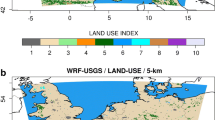Conclusions
The AAQFS is routinely providing highspatial resolution air quality forecasts for guidance for the EPAs in Melbourne and Sydney. Case studies of photochemical smog events in Melbourne and Sydney have given encouraging agreement with observations. Meteorologically the two airsheds present different challenges: in Melbourne it is important to predict the onset and strength of the Port Phillip Bay breeze and the Bass Strait sea breeze; in Sydney is it important to predict the onset and strength of the Tasman sea breeze, the pollution plume trajectory for flow over complex terrain and the effects of local photochemical smog production and inter-regional transport. In the case studied for Sydney there was an additional complication of a synoptic-scale wind surge called the Southerly Buster. For both airsheds, the interaction between synoptic-scale forcing and mesoscale circulations can strongly influence the characteristics of an air pollution event and thus the meteorological model must be able to accurately simulate these interactions. In general, the LCC photochemical mechanism gave better predictions of the 1-hour ozone peak than the GRS mechanism. Improvements to the GRS mechanism and emissions inventory and online modelling of emissions and photochemistry are being developed and implemented. Work on the meteorological model to improve surface winds, soil moisture analysis and boundary-layer height also continues. We have yet to establish the limits of predictability of the system.
Access this chapter
Tax calculation will be finalised at checkout
Purchases are for personal use only
Preview
Unable to display preview. Download preview PDF.
Similar content being viewed by others
References
Azzi, M., Johnson, G. J. and Cope, M., 1992, An introduction to the Generic Reaction Set photochemical smog mechanism, Proc, 11th International Clean Air Conference, Brisbane, 5–10 July 1992, 451–462.
Cope, M. E., Manins, P., Hess, D., Mills, G., Puri, K., Dewundege, P., Tilly, K. and Johnson, M., 1998, Development and application of a numerical air quality forecasting system, Proc, I4th International Conf. Clear Air & Environment, Melbourne, 18–22 October 1998, Clean Air Society of Australia and New Zealand, 353–358.
Cope, M., Hess, D., Lee, S., Azzi, M., Carras, J., Wong, N. and Young, M., 1999, Development of the Australian Air Quality Forecasting System: Current Status, Proc. International Conf. Urban Climatology, Sydney, 8–12 November 1999, in press.
Harley R.A., Russell A.G., McRae G.J., Cass G.R. & Seinfeld J.H., 1993, Photochemical modelling of the southern California air quality study, Environ. Sci. Technol., 27:378–388.
Hess, G. D., Cope, M. E., Lee, S. and Tory, K., 1999, LAPS and the Australian Air Quality Forecasting System, Abstracts of Presentation at the Eleventh Annual BMRC Modelling Workshop, 9–11 November 1999, BMRC Report No. 75, Bureau of Meteorology, Melbourne, 35–40.
Lurmann, F. W., Carter, W. P. and Coyner, L. A., 1987, A surrogate species chemical reaction mechanism for urban scale air quality simulation models, Final Report to US Environmental Protection Agency, Contract No. 68-02-4104.
Puri, K., Dietachmayer, G., Mills, G. A., Davidson, N. E., Bowen, R. A. and Logan, L. W., 1998, The new BMRC Limited Area Prediction System, LAPS, Aust. Met. Mag., 47: 203–233.
Viterbo, P. and Beljaars, A. C. M., 1995, An improved land surface parametrization scheme in the ECMWF model and its validation, Tech. Report 75, Research Department, ECMWF, Shinfield Park.
Author information
Authors and Affiliations
Editor information
Editors and Affiliations
Rights and permissions
Copyright information
© 2004 Kluwer Academic Publishers
About this chapter
Cite this chapter
Hess, G.D. et al. (2004). The Development of the Australian Air Quality Forecasting System: Current Status. In: Gryning, SE., Schiermeier, F.A. (eds) Air Pollution Modeling and Its Application XIV. Springer, Boston, MA. https://doi.org/10.1007/0-306-47460-3_37
Download citation
DOI: https://doi.org/10.1007/0-306-47460-3_37
Publisher Name: Springer, Boston, MA
Print ISBN: 978-0-306-46534-5
Online ISBN: 978-0-306-47460-6
eBook Packages: Springer Book Archive



